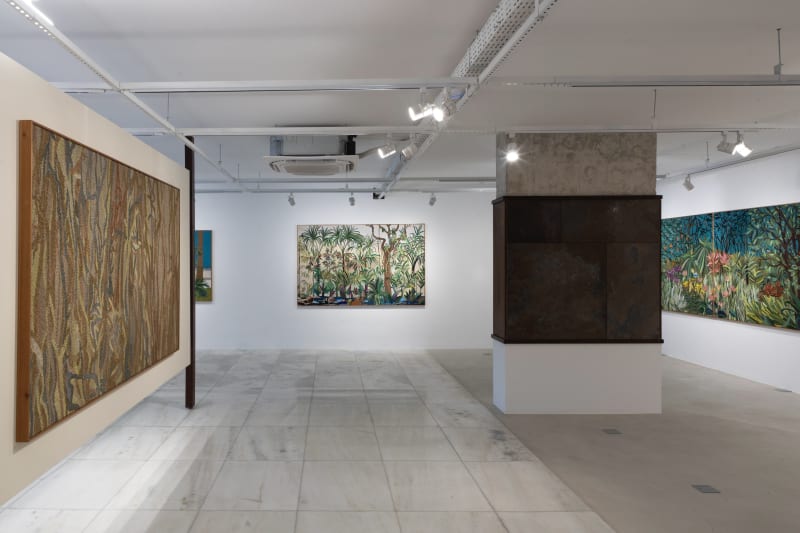Mucki Botkay: imaginary windows: Critical essay: Leonel Kaz
MUCKI: PAINTING WITH BEADS
The forest rustles, swirls, writhes and shakes!
The forest today has something to say
Manuel Bandeira
Just as the great poet from Pernambuco wrote, Mucki’s work is made of forest: contorted, shaken, agitated, with a lot to say. This is what is proposed by the interwoven threads, the diffuse lines, all embroidered on canvas, like a painting—a painting made without paint, but with a material that touches the Brazilian soul: miçangas [beads].
The word “miçanga” is said to have come from “masanga”, a term of African origin meaning “small glass beads”, but it may also have originated from “posanga”, from theancient Tupi language, meaning “ornament”. In the Candomblé, the necklaces of the Orixás are made with these handmade beads; in the Umbanda religion, the bead necklaces are called guia [guide], because they represent each person's Spiritual Guide.
Intertwining these Amerindian and African roots, nothing could be more fitting than for the first major exhibition of Mucki’s beads to take place in Galatea Salvador, the city which, as Brazil’s first capital, made it possible for Europe and Africa to meet on American soil.
For a long time now, the artist has been living between the coasts of Bahia and Rio de Janeiro. Bahia has become part of her soul, as she points out: “I spent many years painting fabrics, but it was utilitarian art and I didn't want that anymore. And then Bahia came along in 2004, transforming everything and showing me a path full of lights and colors. Nature is the magic of inspiration. I love color, I need color.”
Mucki doesn’t work alone. The realization of each work depends on a collective of women embroiderers from Ilhéus and Rio de Janeiro. They are the ones who give the final shape to the works and with whom the artist shares the results: “Embroidery has always made my eyes sparkle and made it possible to do what I do today, which I call ‘painting with beads’. These are works that generate jobs for men and women artisans, partners in making my imagination real. It's very slow work; it was they, the embroiderers, who taught me what it means to be rigorous, patient and calm”.
And how does this complex work, which goes back and forth from hand to hand, happen? Let's take a small step back to understand the beginning of the story. After years of handmade prints, Mucki decided to dye pieces of fabric with 20 or 30 colors; once they were dyed, she cut them out and sewed them onto canvas. In other words, with the material in his hands, there was still no idea of the work that would result. It was only from the cut-outs thrown on the table—it’s no coincidence that Matisse is her idol—that Mucki began her artistic composition. Little by little, small beaded dots were added. And it was only when the beads appeared that the process changed: the fabric cut-outs were abandoned and the beads, always made of glass, began to occupy the entire space of the canvas, creating a unique texture. In the beginning, Mucki used the colors of glass beads that were available on the market; today, she orders from suppliers based on original color scales that are only present in her canvases.
Years ago, I visited an exhibition at the Centre Pompidou in Paris by Ghada Amer, a renowned Egyptian artist who was one of the pioneers of contemporary art using embroidery, dyed fibers and textile inlays. It was a painting and it wasn't. It was a sculpture on the wall and it wasn't. It was just what it was supposed to be: an embroidery that surpassed the craftsmanship contained within itself and gained the status of great art. The same is true in the case of Mucki. She has been working with cloth for decades. On the cloths, she has created colors. On the colors, she has retraced paths, trajectories, dots and stitches. Now, with beads, he creates a new, unique form. After all, isn’t the artist’s job to create something out of the ordinary in order to add to the world what has not yet been seen? This is what she manages to do with her embroidered canvases, in which invisible threads hold beads that make a palette of colors bloom before our eyes. Mucki’s work reverberates what the forest has to say.
Leonel Kaz is a curator and editor


